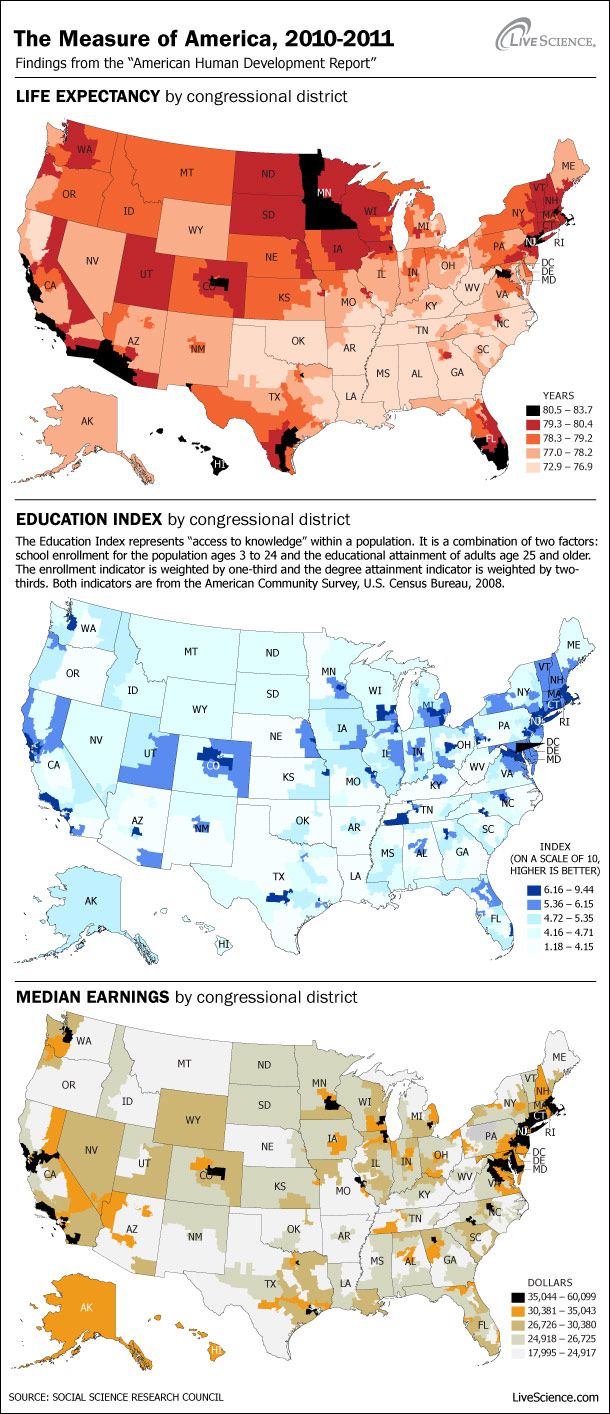Connecticut Residents Are Tops in Well-Being

Connecticut and Massachusetts appear to be the best places to live in the United States if you're interested in enjoying a high rate of well-being, with Arkansas and West Virginia being the worst, according to an analysis of human development released today (Nov. 10).
The Human Development Index focused on three factors of well-being: health (the capacity to live a long and healthy life), education (access to knowledge) and income (the capacity to maintain a decent standard of living).
This measure of well-being, the researchers said, may be a better gauge of how ordinary people are doing than the standard gross domestic product, a measure of the country's economic health. [Infographic: Find out how your state/district fared]
The data for the analysis came from various government reports and included calculations by the research team. It was analyzed on different levels: by states, congressional districts, ethnicity/race and gender.
Some areas and groups have surged ahead of others in the face of the recession, said study co-author Kristen Lewis, co-directors of the American Human Development Project of the Social Science Research Council, a nonprofit international organization based in New York.
"People who are on solid ground before a crisis hits … stand a much better chance of weathering shocks and bouncing back," Lewis told LiveScience. For instance, the rate of unemployment and underemployment for people who didn't complete a high school degree was 35 percent in the last quarter of 2009. For those with at least a high school degree, that number was only 7 percent.
"Overall, the recession hit people with less education much harder than those with more education," she said.
Sign up for the Live Science daily newsletter now
Get the world’s most fascinating discoveries delivered straight to your inbox.
As for how to boost a group's well-being, Lewis said it's all about "policies that invest in people," including educational and health initiatives. For instance, she said, the states that fared best in the education index all spent at least $14,000 per pupil per year, while those scoring lowest spent less than $5,000 per student per year.
The three indices were combined into the overall Human Development Index.
The top five U.S. areas on the overall Human Development Index:
- Connecticut
- Massachusetts
- Washington, D.C.
- New Jersey
- Maryland
The bottom five states:
- Alabama
- Louisiana
- Mississippi
- Arkansas
- West Virginia
Where people live the longest
Life expectancy in the United States is 78.6 years, on par with Chile, though Chile spends one-tenth what the United States spends on health care, the report finds.
Hawaiians have the longest life expectancy of any U.S. residents, 81.5 years, while Mississippians have the shortest, 74.8 years. In the continental United States, Minnesota took the top spot for life expectancy, at 80.9 years.
The differences between Minnesota and Mississippi are stark, as Lewis points out. In Minnesota, nine out of 10 people have health insurance, compared with one in five in Mississippi. People in Minnesota smoke less than the national average, have more funding for preventative public health services, and have one of the lowest overall obesity and childhood obesity rates in the country. Furthermore, nine out of 10 residents have at least a high school diploma. Mississippi has the highest rates of obesity and childhood obesity in the country and the second highest rate of diabetes, behind only West Virginia.
The 11 states with the shortest life spans are in the South, which Lewis said is partly due to social determinants of birth (conditions a person is born into), and partly because of behavioral risks such as smoking, physical inactivity, drinking to excess, and poor diet. (These risks were referred to as "The Fatal Four" by the researchers.) [Smoking: A 'Winnable' Public Health Battle?]
Even within Washington, D.C., which finished high in the index when ranked alongside the 50 states, there was lots of variability. White residents of the city live, on average, 12 years longer than African-Americans there — a consequence of what Lewis refers to as "two Washingtons," one composed of affluent, highly educated individuals who have moved there for jobs, and the other made up of African-American communities with poor public services.
Lewis added: "The idea that a baby born today in the suburbs of Washington, D.C., can expect to live a full decade more than a baby born one state over in West Virginia is pretty astonishing." She said the reasons for the difference include various social and economic factors, including low levels of educational attainment in West Virginia.
Other gaps
In education and income there are equally large gaps. For instance, in Congressional District 29 in the Houston area, only 54 percent of adults over 25 have completed a high school degree, compared with 97 percent who have done the same in Congressional District 6 in the Denver area. The gap could have to do with a poor education system, large immigrant population or other factors, Lewis said.
As far as income gaps, gender loomed large: White and Asian-American men earn just shy of $41,000 as a median annual salary, whereas Latina women earn less than half that. Overall men earn $11,000 more per year than women in the country.
To step up in education, health and income, the researchers suggest preventative services to stop, say, a person from even developing diabetes or to keep residents in school and out of prison. Other recommendations include: making healthy choices easy (making it safe for kids to play outdoors, supporting farmer's markets or other healthy food establishments); and using economic incentives to promote healthy behaviors and to invest in people.
Survey methods
The American Human Development Project is a nonpartisan initiative of the Social Science Research Council.
The health index was measured using life expectancy at birth, calculated from mortality data from the Centers for Disease Control and Prevention, National Center for Health Statistics 2007, and population data from the CDC WONDER database.
Access to knowledge was measured using two indicators: school enrollment for the population age 3 and older, and educational degree attainment for the population 25 years and older. Both indicators are from the American Community Survey, U.S. Census Bureau, 2008.
A "decent standard of living" was measured using median earnings of all full- and part-time workers 16 years and older from the American Community Survey, U.S. Census Bureau, 2008.
Jeanna Bryner is managing editor of Scientific American. Previously she was editor in chief of Live Science and, prior to that, an editor at Scholastic's Science World magazine. Bryner has an English degree from Salisbury University, a master's degree in biogeochemistry and environmental sciences from the University of Maryland and a graduate science journalism degree from New York University. She has worked as a biologist in Florida, where she monitored wetlands and did field surveys for endangered species, including the gorgeous Florida Scrub Jay. She also received an ocean sciences journalism fellowship from the Woods Hole Oceanographic Institution. She is a firm believer that science is for everyone and that just about everything can be viewed through the lens of science.











